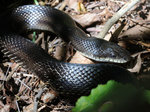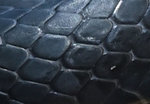Most of us have been out in the woods at one time or another, and spotted a snake or two. Maybe a couple of those snakes were black in color, and if we were lucky, they stayed still long enough for us to get a good look at them. We could have even spotted one of these so-called black snakes climbing up the trunk of a tree or the side of a building.
Stay informed about your community and support local independent journalism.
Subscribe to The River Reporter today. click here
This item is available in full to subscribers.
Please log in to continue |



Most of us have been out in the woods at one time or another, and spotted a snake or two. Maybe a couple of those snakes were black in color, and if we were lucky, they stayed still long enough for us to get a good look at them. We could have even spotted one of these so-called black snakes climbing up the trunk of a tree or the side of a building.
In this region, the large “black snake” we saw could be one of two distinct species of snake; the two are easily confused.
The northern black racer (Coluber constrictor) is a common, nonvenomous snake in the region. It is often found in more open areas, such as fields near forest edges or rocky areas. Black racers can grow to over six feet long, and, as their name implies, they can be quick when they need to get away.
If you manage to get reasonably close, you might notice a black snake’s shiny, wide non-keeled scales. (Keeled scales have a vertical ridge.)
Although nonvenomous, this species may try to bite if handled; its bite feels somewhat like getting your hand caught in a blackberry bush.
The other “black snake” is the eastern rat snake (Pantherophis alleghaniensis). Rat snakes are of a similar color and size to the racer, but a rat snake will show a bit more white under the chin.
Rat snake scales are smaller than racer scales; rat snake scales are also keeled. This is a useful means of identification even if the snake is mostly covered or otherwise hidden.
Rat snakes are mammal eaters, and will also prey on small birds and their eggs.
Both species can be seen during the early fall on mild days; they are likely to be out through the month of October if mild weather prevails. You might spot one during a fall hike, and might be able to get close enough, or use binoculars to see the “black snake” for what it really is.
Give the snakes a respectful distance, especially if you are new to identifying snakes or otherwise cannot make a positive ID.
Comments
No comments on this item Please log in to comment by clicking here